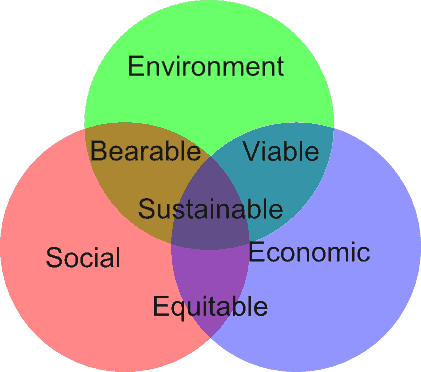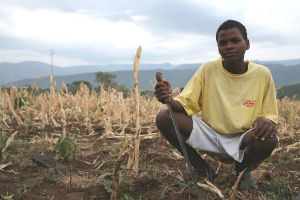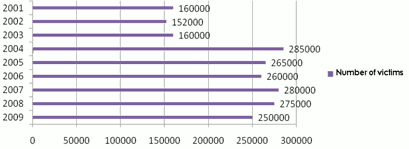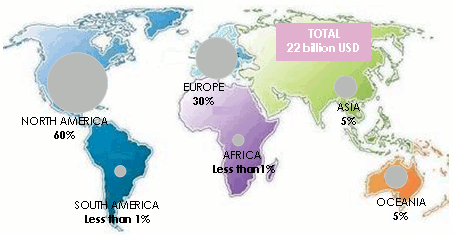The stakes behind climate change
Since the 1970s, we have gone beyond the planet's carrying capacity, which led to a spectacular 30% decrease of the natural resources in 30 years time: forest ecosystems have been reduced by 12%, fresh water by 50% and marine ecosystems by 30%.
In an era characterized by threatening and dangerous climate changes as well as by more and more limited and precarious natural resources, the notion of sustainable development has turned out to be indispensable for all countries without exception.
Evolution of the ozone layer since 1979

Definition of sustainable development
Sustainable development as defined by the United Nations World Commission on Environment and Development is that which meets the needs of the current generations without endangering the capacity of the next generations to satisfy theirs.
Characteristics of sustainable development
 Sustainable development is an economically-efficient development, socially equitable and ecologically bearable.
Sustainable development is an economically-efficient development, socially equitable and ecologically bearable.
The sustainable development is respectful of the natural resources and ecosystems. It ensures economic efficiency without losing sight of the social finalities which are: the struggle against poverty, inequalities, ...
Historical background, conferences and international agreements
- 1968:Creation of the Club of Rome to undercut the boundaries of economic growth
- June 5-16, 1972:The United Nations Conference on the Human Environment in Stockholm: defining the link between ecology and economy
- 1980:First mention of the notion of sustainable development in a report published by the International Union for Conservation of Nature
- 1987:The World Commission on Environment and Development proposed a definition of sustainable development
- June 3-14, 1992:Earth Summit in Rio de Janeiro: Adoption of the Agenda 21 with a list of 2500 action recommendations for the 21st century
- June 23-27, 1997:The second Earth Summit, New York, updating the Agenda 21
- December 1-12, 1997:The Kyoto Protocol: Adoption of a protocol to the United Nations framework convention on climate change on the reduction of the greenhouse gas concentrations
- August 26-September 4, 2002:The Johannesburg Summit: More than one hundred Heads of States, thousands of governmental and NGO representatives ratified a treaty calling for the conservation of natural resources and biodiversity
- 2005:Entry into effect of the Kyoto Protocol on the reduction of greenhouse gas concentrations in the European Union
- December 7-18, 2009:The Copenhagen Summit: More than 192 Heads of States and governments from all over the world gathered to finalize a new international agreement on climate
Sustainable development in Africa and the Middle East
In Africa
 Africa's development, oriented toward the developed countries, has exposed the regional countries to climate changes, water shortage, ...
Africa's development, oriented toward the developed countries, has exposed the regional countries to climate changes, water shortage, ...
The African economy relies on its natural resources which stand as a livelihood for the most of the population. As such, Africa cannot, therefore, risk to lose its environmental assets.
Even though Africa emits relatively less pollutant gases than the industrial countries, it remains true that it is suffering the consequences of industrial countries' pollutant gases.
For three decades, Africa's environment has relentlessly been deteriorated and poverty continued to increase despite the initiatives taken by the governments to try to slowdown and reverse this degradation.
For the Kenyan people, the effects of climate change result in serious shortages of food, water and electricity which strain budgetary resources and which, in a context of worldwide economic crisis, darken the country's perspectives of a possible recovery.
Sub-Saharan African countries are the hardest hit by the climate change. It has been proven that the region development is vulnerable to climate change, a consequence of the greenhouse gas emission by the industrial countries.
Significant figures
- African countries account for less than 4% of CO2 emissions worldwide.
- Climate change experts estimate that a 2°C rise in the earth's temperature in comparison with preindustrial era could trigger a permanent reduction of 4 to 5% of the annual per capita consumption in Africa.
- The African continent is suffering from its fragile physical features as it remains exposed to risks of droughts and floods which are poised to worsen with the current climate trend. Many regional countries have sustained disastrous floods, a phenomenon that was rare in the past. In 2000, the floods that inundated Mozambique are estimated to have cost the country damages worth 550 million USD , that is, 1.5% of the national GDP.
- 86% of the Sub-Saharan African lands are in a critical situation.
- By 2030, the number of Africans exposed to malaria, a climate-related disease, will have increased by 90 millions, that is, a 14% progression.
- Africa is dotted with an enormous potential of renewable energies. Yet it is using only 8% of its potential of hydroelectric power, whereas Latin America is using 30% of its potential.
In the Middle East

- Water resources are getting scarcer and scarcer in the Middle Eastern region.
- The World Bank is forecasting a decrease in the per capita renewable water resources of 1045m3 per year at 740m3 per year by 2015.
- The degradation of arable lands is accelerated by the inopportune management of the natural resources.
- Pollution-related health problems are increasing, especially in industrial zones.
- Coastal areas in the Middle East are deteriorating.
The World Bank assistance program for the improvement of the environment and the reduction of degradation risks in the Middle East are focused on three complementary axes:
- To further raise awareness among decision makers about the extent of environmental degradation and its consequences,
- To prevent and reduce environmental degradation through the improvement of regulatory frameworks and a more rigorous enforcement of the legislations in force,
- To create incentives for the institution of good environmental practices.
Number of natural catastrophes / number of victims worldwide

 * A natural catastrophe refers to any event caused by the force of nature which triggers multiple losses.
* A natural catastrophe refers to any event caused by the force of nature which triggers multiple losses. The climatic stakes at the core of the insurers' consideration
The most costly natural events: 2007-2009
in USD| Event | Loss cost | Insured sum | |
|---|---|---|---|
| 2007 | |||
January | Storm Kyrill (Europe) | 10 billion | 5 billion |
April | Tornado (USA, Canada) | 2 billion | 1.5 billion |
June | Cyclone Gonu and tropical storm (Oman, Iran) | 3.9 billion | 0.650 billion |
July | Floods (United Kingdom) | 4 billion | 3 billion |
October | Brushwood fires (United States, Canada) | 2.7 billion | 2.3 billion |
| 2008 | |||
January | Snow storm (China) | 10 billion | 1.6 billion |
March | Storm Emma (Europe) | 2 billion | 1.5 billion |
May | Earthquake (China) | 20 billion | 1.5 billion |
May | Cyclone Nargis (Burma) | 10 billion | - |
June | Floods (USA) | 10 billion | 1 billion |
| 2009 | |||
24 January | Winter storm Klaus (France, Spain) | 5.1 billion | 3.5 billion |
7 February | Victoria bush fire, winds up to 100 km/h (Australia) | 1 billion | 950 million |
10 February | Winter storm (USA) | 2.5 billion | 1.3 billion |
9 April | Tornadoes, storms with winds up to 105 km/h (USA) | 2 billion | 1 billion |
23 July | Hail, storm (Switzerland, Austria, Poland, Czech Rep.) | 2 billion | 1.2 billion |
Natural catastrophes by region in 2009: cost for insurers
Breakdown by continent in % in millions USD
| Total losses | Nbr of victims | |
|---|---|---|
Africa | 500 | 720 |
America | 22 0000 | 800 |
Asia | 11 500 | 7 400 |
Australia/Oceania | 3 000 | 450 |
Europe | 13 000 | 670 |
Total | 50 000 | 10 040 |
The natural catastrophes have cost damages worth 50 billion USD in 2009, 22 billion of which were covered by insurance.
The most important natural catastrophes occuring in 2010*
in USD| Event | Loss cost | Insured sum | |
|---|---|---|---|
12 January | Earthquake (Haiti) | NA | NA |
27 February | Violent earthquake (Chile) | Between 15 and 30 billions | About 8 billions |
28 February | Storm Xynthia (Europe) | NA | 1.8 billions |
22 March | Storms and hail falls (Australia) | NA | 600 millions |
16 May | Floods (Poland) | 2.9 billions | NA |
May | Storms and floods (China) | 6.6 billions | NA |
13 June | Floods (China) | 6.2 billions | NA |
Most devastating technological and oil catastrophes
- July 10, 1976: Seveso (Italy). A dioxin cloud is released from a reactor of Icmesa's chemical plant. Four communes, including Seveso were affected, 3 300 domestic animals were intoxicated, 70 000 cattle were culled.
- March 16, 1978: The sinking of the Liberian oil tanker Amoco Cadiz triggered a big oil slick along the Breton coasts, more than 400 km were polluted and more than 35 fish species were affected.
- December 3, 1994: Bhopal: The biggest industrial catastrophe claimed the lives of 4000 to 6000 people
- April 26, 1986: Chernobyl: A nuclear reactor exploded releasing a radioactive cloud in the atmosphere covering 40% of the European territory causing the death of 4 500 people.
- March 24, 1989: The oil tanker Exxon Valdez ran aground the coasts of Alaska and triggered a big oil slick, more than 7 000km2 of layers polluted 800km of coasts.
- April 20, 2010: Explosion and sinking of the oil rig Deepwater Horizon off the coasts of the Gulf of Mexico, triggering an oil spill from a well located at 1525 meters below the sea.
Why sustainable development ?
 The commitment and the adoption of a sustainable development policy is a prerequisite that will allow Africa and the Middle East to prosper by learning how to save and to share resources fairly through the use of least polluting technologies, which waste less water and less energy, and especially by changing our consumption habits and our behaviors. We can say that development cannot be sustainable if it threatens ecology.
The commitment and the adoption of a sustainable development policy is a prerequisite that will allow Africa and the Middle East to prosper by learning how to save and to share resources fairly through the use of least polluting technologies, which waste less water and less energy, and especially by changing our consumption habits and our behaviors. We can say that development cannot be sustainable if it threatens ecology.
- To combat lands' degradation, drought and desertification
- To preserve the wet zones in Africa
- To prevent, control and manage invasive exotic species
- To conserve and endeavor for the sustainable use of marine and coastal sources along with fresh water
- To combat climate change
- To conserve or manage transboundary natural resources
Sustainable development: a priority for insurers
The large-scale phenomena are scaring the insurers because of the damages they cause and the losses pertaining to the indemnifications which ensue.
By 2030, the indemnification of material damages related to natural events is likely to double and reach 75 billion USD. In view of this fact, the policy of sustainable development is set to get more and more in line with the strategy of the insurers who should be prepared to support increasing expenses.
Insurers, whose major role is to anticipate the risk, find it hard to assess the claims resulting from climate disruptions. Today, it is impossible to know about the intensity, the place and the duration of a climate event.
Introducing new calculation parameters according to the globe temperature and to the number of earthquakes… are a priority for the professionals of the insurance business keen on quantifying an ever growing and frequent risk.
During the last decade, the insurers have used more and more sophisticated probabilistic models in order to quantify major risks such as earthquakes, tropical cyclones and winter storms in Europe.
Nevertheless, the capacity to correctly evaluate the potential of the natural catastrophes- related claims remains insufficient.
Earthquakes are the most significant catastrophes. The damages caused by an earthquake are by far bigger than those of storms or floods.
Insurer's attitude towards natural catastrophes
In order to limit the losses triggered by a natural catastrophe, insurers may:
- Reduce their risk by transferring it to other economic players: State, financial markets, ...
- Decline part of the risk by limiting the value of the insured risks,
- Increase the insurance premiums,
- Transfer the risks through the mechanism of reinsurance.